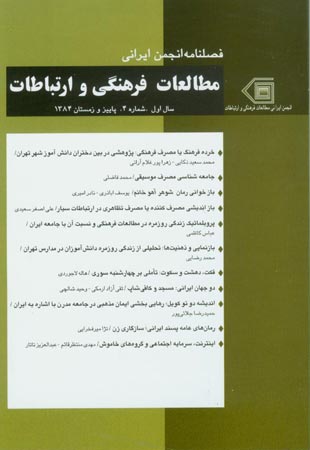فهرست مطالب

فصلنامه مطالعات فرهنگی و ارتباطات
پیاپی 4 (پاییز و زمستان 1384)
- 262 صفحه،
- تاریخ انتشار: 1384/12/20
- تعداد عناوین: 11
-
-
صفحه 1
تحولات چشم گیر در عر اصه فناوری ارتباطات و رشد مصرف گرایی نقش فرهنگ رسانه ای و فرهنگ عامه پسند جهانی در جامعه پذیری جوانان را افزایش داده است. از جمله نتایج تحولات فوق ، ظهور خرده فرهنگ ها و سبک زندگی متنوعی در بین جوانان است که گاه با فرهنگ رسمی جامعه همخوان نبوده و گاه آنرا به چالش می کشد. در مطالعه حاضر که بر روی نمونه ای معرف از دانش آموزان دختر دبیرستانی تهران صورت گرفته است میزان گرایش دختران به رفتارها خرده فرهنگی بررسی می شود. در این مقاله نشان داده می شود که شکاف در جهت گیری های ذهنی و رفتاری دختران نوجوان نسبت به و مولفه های خرده فرهنگی ، تناقصاتی را در هم زمان آنها به ارزش ها سنتی و مدرن به همراه دارد از سوی دیگر گرایش به رفتارهای خرده فرهنگی آن چنان فراگیر شده است که تمایز آن از رفتارهای مقبول رسمی دشواره گردیده و مرزبندی های این دو سطح نگاه و رفتار را درمعرض تغییر و تعریف مجدد قرارمی دهد.
کلیدواژگان: خرده فرهنگ، سبک زندگی، عامه پسند، مصرف رسانه ای، مصرف فرهنگی -
صفحه 27
یکی از دغدغه های نظری مهم در عرصه جامعه شناسی فرهنگ این است که چه عواملی نوع و میزان مصرف فرهنگی مردم را تعیین می کنند به میزانی که محصولات فرهنگی در جوامع افزایش می یابد و مصرف فرهنگی نقش بیشتری در خلق هویت ها و اقتصاد فرهنگ ایفاد می کنن، طرح این پرسش نیز اهمیت بیشتری میابد. به همین ترتیب پاسخ به آن بخشی از تلاش ها برای روندنمایی تغییرات اجتماعی و فرهنگی جامعه نیز هست. مقاله حاضر نیز به طرح این پرسش می پردازد نوع و میزان مصرف موسیقی تحت تاثیر چه عواملی است. برای پاسخ دادن به ان از منظر تحلیل طبقاتی به مصرف موسیقی نگریسته شده است. طبقه اجتماعی و سرمایه فرهنگی به عنوان دو متغیر کلیدی نظریه های کلاسیک تبیین مصرف فرهنگی طرح شده است و سپس بر مبنای مطالعه تجربی مصرف موسیقی در شهر تهران، تلاش شده است و سهم این عوامل در تبیین ذایقه موسیقیایی مشخص شود. در این مقاله براساس شواهد تجربی، نظرهای طبقاتی تبیین کننده ذایقه موسیقیایی نیز نقد می شود.
کلیدواژگان: موسیقی، مصرف فرهنگی، مصرف موسیقی، سرمایه فرهنگی، ذائقه موسیقایی -
صفحه 55
نویسندگان مقاله حاضر، رمان تاریخ گرایی را از زاویه سازو کل بازسازی حافظه جمعی و روایت بازخوانی می کنند. ابتدا اشاراتی به تکیه گاه های نظری این نوشتار خواهد شد سپس شرحی از حقایق داستانی شوهر آهو خانم ارایه خواهد شد. آنگاه دربخش نهایی و اصلی مقاله، خصلت گفت و گویی رمان ، سطوح روایتی آن و نیز چگونگی بازسازی گذشته اجتماعی بر مبنای مولفه های خصلت گفت و گویی رمان، سطوح روایتی آن و نیز چگونگی بازسازی گذشته اجتماعی بر مبنای مولفه های نگارش عصر تحلیل آن خواهد شد.
کلیدواژگان: روایت گرایی، قاعده گفت و گویی، گفتمان رمان وار، اقتدار نویسنده، سطوح روایت، حافظه جمعی، بازسازی تاریخی -
صفحه 163
-
Page 1
Significant developments in the field of communication technology and the growth of consumerism have increased the role of media culture and global popular culture in the socialization of young people. Among the results of the above developments is the emergence of subcultures and diverse lifestyles among young people, which are sometimes inconsistent with the official culture of society and sometimes challenge it. In the present study, which was conducted on a representative sample of female high school students in Tehran, the extent of girls' tendency to subcultural behaviors is investigated. This article shows that the gap in the mental and behavioral orientations of adolescent girls towards and subcultural components, at the same time brings them contradictions to traditional and modern values. On the other hand, the tendency to its subcultural behaviors. It has become so pervasive that it has become difficult to distinguish it from officially accepted behaviors, exposing the boundaries of these two levels of view and behavior.
Keywords: Subculture, lifestyle, popular culture, Media Consumption, cultural consumption Subculture or cultural consumption -
Page 27
One of the important theoretical concerns in the field of sociology of culture is what factors determine the type and amount of cultural consumption of people to the extent that cultural products increase in societies and cultural consumption plays a greater role in creating cultural identities and economics. Now, the question becomes even more important. Likewise, responding to it is part of the effort to streamline social and cultural change in society. The present article also addresses the question of what factors affect the type and amount of music consumption. To answer this, music consumption has been viewed from the perspective of class analysis. Social class and cultural capital have been proposed as two key variables of classical theories of explaining cultural consumption, and then based on the empirical study of music consumption in Tehran, an attempt has been made to determine the contribution of these factors in explaining musical taste. In this article, based on empirical evidence, class theories that explain musical taste are also criticized.
Keywords: music, Cultural Consumption, music consumption, Cultural Capital, musical taste -
Page 55
The authors of the present article read the novel of historicism from the perspective of the whole mechanism of collective memory and narrative reconstruction. First, there will be references to the theoretical foundations of this article, then a description of the fictional facts of Ahoo Khanum's husband will be provided. Then, in the final and main part of the article, the dialogue character of the novel, its narrative levels and also how to reconstruct the social past based on the components of the novel dialogue character, its narrative levels and how to reconstruct the social past based on the writing components of the era will be analyzed.
Keywords: Narrativeism, Rule of Dialogue, Narrative Novel Discourse, Author Authority, Narrative Levels, Collective memory, Historical Reconstruction

